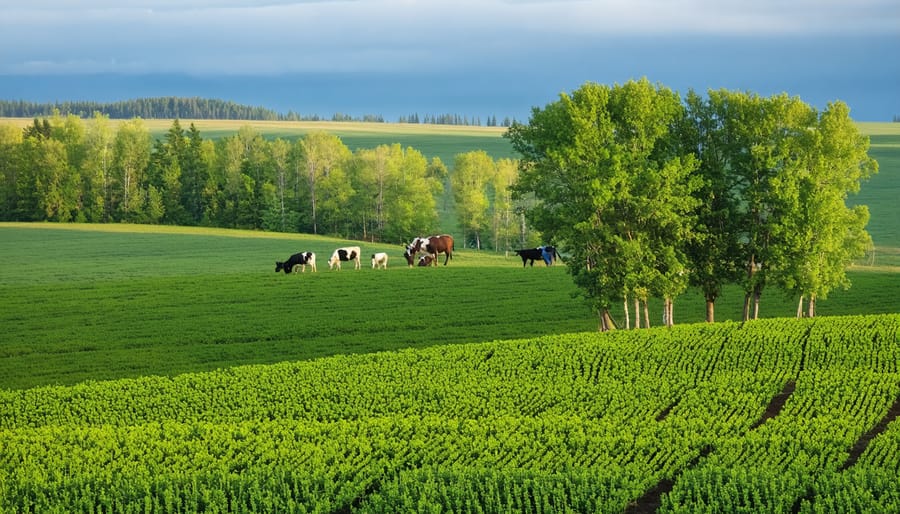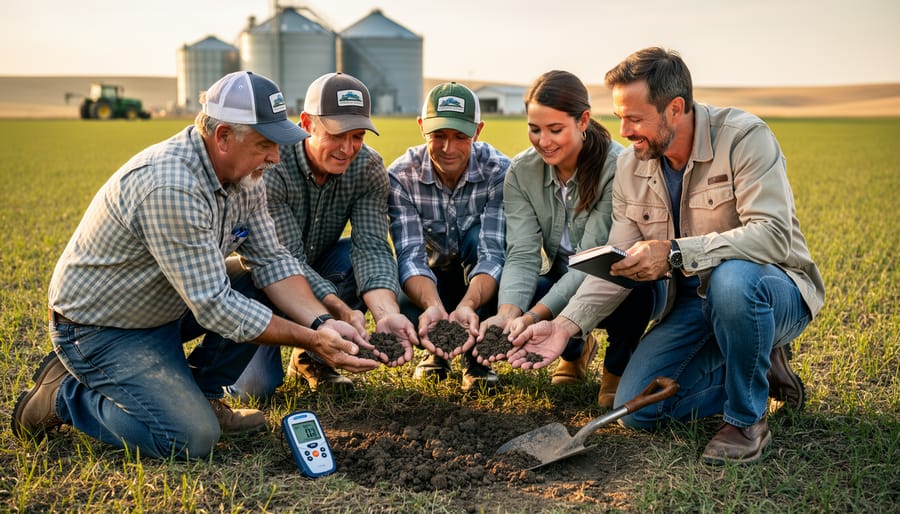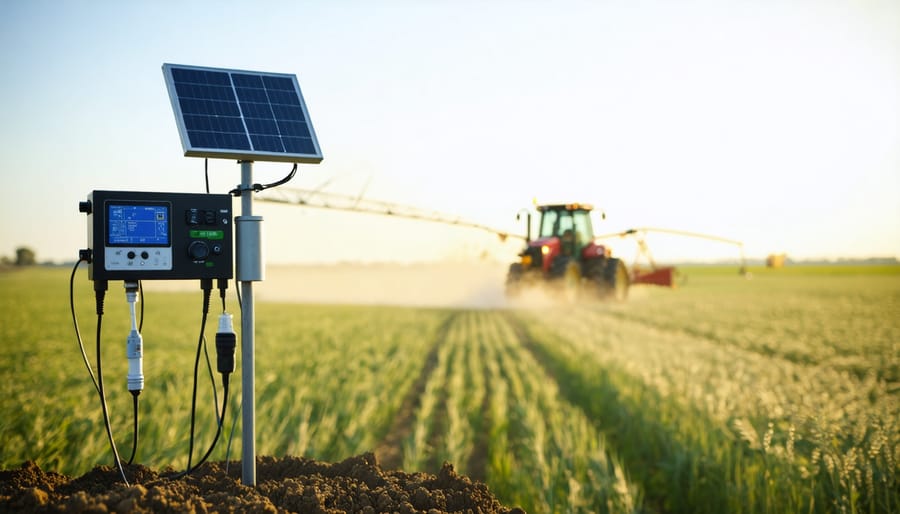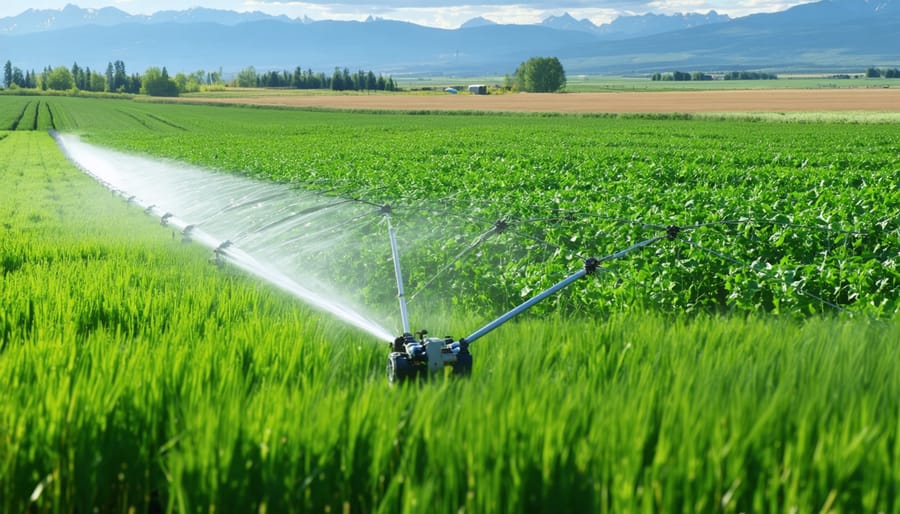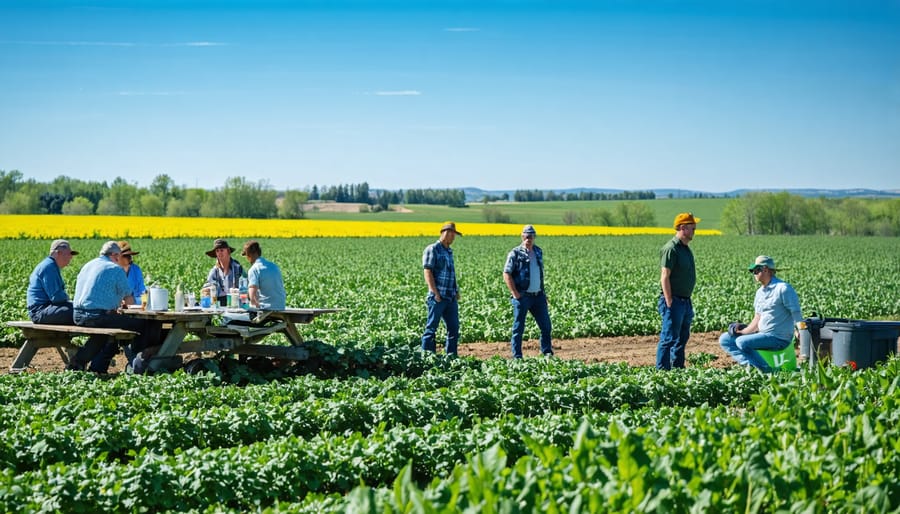The National Agroforestry Center stands at the forefront of transforming Canadian agriculture through innovative land management practices that combine trees, crops, and livestock. Operating as a vital hub for climate-resilient farming solutions, the center empowers Alberta’s farmers with research-backed strategies that boost farm productivity while protecting our natural resources. Through its network of demonstration sites across the prairie provinces, hands-on training programs, and collaborative research initiatives, the center has helped more than 5,000 Canadian farmers integrate sustainable agroforestry systems into their operations since 1995. Today, as climate challenges intensify and soil health becomes increasingly critical, the center’s expertise in windbreak design, silvopasture systems, and riparian buffers offers practical solutions for farmers seeking to enhance their land’s resilience while maintaining profitable operations. From small-scale family farms to large agricultural enterprises, the National Agroforestry Center provides the tools, knowledge, and support needed to successfully implement agroforestry practices that work in Canada’s unique growing conditions.
The National Agroforestry Center’s Impact in Alberta
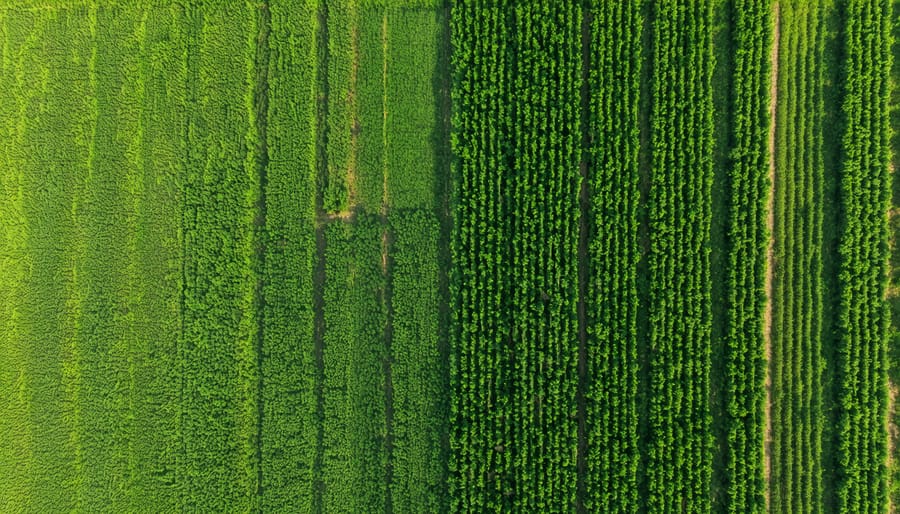
Local Research and Development Initiatives
The National Agroforestry Center’s Alberta division currently leads several groundbreaking research initiatives tailored to the province’s unique growing conditions. A notable project in Red Deer County examines windbreak designs specifically engineered for the prairie climate, helping farmers reduce soil erosion while maximizing crop yields.
In partnership with local agricultural societies, researchers are studying indigenous berry species integration within traditional farming systems. This project, spanning five sites across central Alberta, demonstrates how native plants can enhance biodiversity while providing additional income streams for farmers.
Climate adaptation research remains a priority, with ongoing trials in moisture conservation techniques and frost-hardy species selection. The Center’s demonstration farm near Lacombe showcases innovative silvopasture systems, where cattle graze among hybrid poplar trees, providing valuable data on livestock performance and soil health improvement.
Current field trials also focus on measuring carbon sequestration rates in various agroforestry systems, helping Alberta farmers participate in carbon credit programs while contributing to climate change mitigation efforts. Regular field days and workshops connect researchers directly with farmers, ensuring research outcomes translate into practical, on-farm solutions.
Farmer Success Stories
Meet Dave and Sarah Thompson from Lacombe County, who transformed their 160-hectare farm by integrating shelterbelts and silvopasture systems. After implementing these practices in 2018, they’ve reported a 30% increase in cattle weight gain and significant improvement in crop yields during drought years.
In the Peace River region, Robert Chen’s innovative approach to windbreaks has become a model for other farmers. His strategic placement of hybrid poplar and white spruce not only protects his crops from harsh winds but also provides an additional revenue stream through sustainable wood harvesting.
The Mason family in Strathcona County showcases the success of riparian buffers along their creek system. Their careful management has improved water quality, reduced soil erosion, and created habitat for pollinators. Their berry production has increased by 25% since establishing the buffers five years ago.
These success stories demonstrate how Alberta farmers are leading the way in sustainable agriculture while improving their bottom line. Each case represents years of collaboration with the National Agroforestry Center, proving that environmental stewardship and profitable farming can go hand in hand.
Educational Resources and Training Programs
Workshops and Field Days
The National Agroforestry Center offers hands-on learning experiences through seasonal workshops and field days, providing invaluable opportunities for farmers and land managers to witness successful agroforestry systems firsthand. These events typically run from May through September, taking advantage of the growing season to showcase real-world applications across Alberta’s diverse agricultural landscape.
Workshops combine classroom-style learning with practical field demonstrations, covering essential topics like shelter belt design, Indigenous food forestry, and silvopasture management. Participants learn directly from experienced practitioners and can network with fellow farmers who have successfully integrated trees into their agricultural operations.
Field days offer immersive experiences on working farms, where attendees can observe mature agroforestry systems and discuss implementation strategies with host farmers. These sessions typically run for 6-8 hours and include guided tours, soil assessment demonstrations, and discussions about species selection for different climate zones.
Recent highlights include the popular “Getting Started with Windbreaks” workshop series and the annual “Silvopasture Success Stories” field tour, which connects new practitioners with established mentors. The Center also offers specialized training for agricultural professionals and conservation planners, helping build local expertise to support agroforestry adoption across the region.
To accommodate diverse schedules, many workshops are now available in both in-person and virtual formats, with recordings accessible through the Center’s online learning platform.
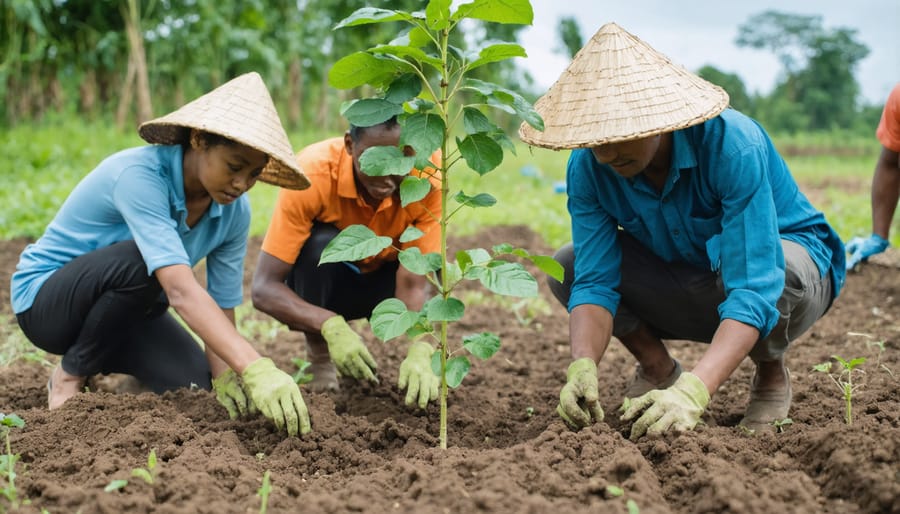
Online Learning Platform
The National Agroforestry Center’s online learning platform offers a comprehensive suite of digital learning resources tailored to Canadian farmers and agricultural professionals. Through this user-friendly platform, participants can access self-paced courses, interactive webinars, and practical tutorials that bring agroforestry concepts directly to their farms.
The platform features region-specific content, with modules designed specifically for Alberta’s climate and growing conditions. Farmers can explore topics ranging from windbreak establishment and silvopasture management to indigenous agroforestry practices, all through high-quality video demonstrations, downloadable guides, and virtual field tours.
A standout feature is the peer-learning community, where participants connect with fellow farmers across Canada to share experiences and solutions. Monthly live sessions with agroforestry experts provide opportunities for real-time questions and discussions about implementation challenges.
The center regularly updates its course catalog based on participant feedback and emerging research. All materials are available in both English and French, with closed captioning options to ensure accessibility. Farmers can track their progress through customized learning paths and earn certificates upon completing specific program modules, supporting professional development in sustainable agriculture practices.
Climate Resilience Through Agroforestry
Tree Integration Strategies
The National Agroforestry Center promotes several effective strategies for integrating trees into existing agricultural systems, helping Canadian farmers enhance their sustainable farming practices. For Alberta farmers, the most successful approaches include shelterbelts, silvopasture, and riparian buffers.
Shelterbelts, consisting of strategically planted rows of trees and shrubs, protect crops and livestock from harsh prairie winds while improving soil moisture retention. Typical configurations include 3-5 rows of mixed species, with fast-growing varieties like hybrid poplars combined with longer-lived species such as white spruce.
Silvopasture systems integrate trees with livestock grazing areas, providing shade during hot summers and shelter in winter. This method has shown particular success in central Alberta, where farmers report up to 20% increased cattle weight gain and improved pasture productivity. Common tree species include green ash and Manitoba maple, planted at densities of 200-400 trees per hectare.
Riparian buffers along waterways help prevent erosion and filter agricultural runoff. These systems typically extend 10-30 metres from water edges, incorporating native species like willows and dogwoods. Many Alberta farmers have successfully established these buffers while maintaining productive cropland.
The Center recommends starting with small-scale trials, typically 1-2 hectares, to test different tree integration methods. Through their mentorship program, new adopters can connect with experienced agroforesters who have successfully implemented these systems in similar climate conditions. This practical, community-based approach helps ensure higher success rates and builds local expertise.
Soil Health Management
Soil health management is a cornerstone of successful agroforestry systems, particularly in Alberta’s diverse agricultural landscape. Through strategic integration of trees and shrubs with conventional farming practices, farmers can significantly enhance soil structure and fertility while building long-term resilience.
Studies conducted across Canadian prairie regions demonstrate that agroforestry practices can increase organic matter content by up to 2% over five years. This improvement comes primarily through leaf litter decomposition and root system development, which create natural nutrient cycling processes that benefit both soil and crops.
Local Alberta farmer Mike Thompson shares his experience: “Since incorporating shelterbelts on my property, I’ve noticed less soil erosion during our strong spring winds. The soil holds moisture better, and I’m seeing more earthworms than ever before.”
Key soil management strategies include:
– Establishing windbreaks to reduce soil erosion and maintain moisture
– Implementing alley cropping systems that promote nutrient cycling
– Using nitrogen-fixing species like caragana and sea buckthorn
– Maintaining year-round soil coverage through strategic tree placement
– Encouraging beneficial soil microorganisms through reduced tillage
Monitoring soil health is essential for success. Simple assessment methods include checking soil aggregation, measuring organic matter levels, and observing earthworm populations. The Center provides soil testing guidelines and interpretation services to help farmers track their progress.
For optimal results, consider your specific soil type and local climate conditions when selecting tree species and planning their placement. The Center’s soil specialists can help develop customized management plans that align with your farm’s unique characteristics and production goals.

Support Services and Resources
Technical Advisory Services
The National Agroforestry Center offers comprehensive technical advisory services tailored to Canadian farmers’ unique needs and challenges. Our team of experienced agricultural specialists provides personalized consultation to help producers integrate agroforestry practices with modern agricultural techniques.
Farmers can access one-on-one consultations where experts assess their land, soil conditions, and current farming practices to develop customized agroforestry implementation plans. These consultations include detailed site evaluations, species selection guidance, and economic feasibility assessments to ensure successful integration of trees and crops.
Our advisory team also offers ongoing support through various channels, including virtual consultations, on-site visits, and regular check-ins during critical implementation phases. We understand that each farm is unique, and our advisors work closely with producers to address specific challenges while considering local climate conditions and market opportunities.
Technical support extends to soil management strategies, irrigation planning, and biodiversity enhancement techniques. Our experts can help farmers access relevant funding programs and connect with other producers who have successfully implemented agroforestry systems.
Whether you’re just starting to explore agroforestry or looking to optimize existing systems, our advisory services provide the practical guidance needed to enhance farm productivity while promoting environmental sustainability.
Funding and Grant Opportunities
The National Agroforestry Center offers several funding pathways to support Canadian farmers in implementing sustainable agroforestry practices. Through partnerships with Agriculture and Agri-Food Canada, farmers can access cost-sharing programs that cover up to 50% of eligible expenses for establishing agroforestry systems on their land.
The Environmental Farm Plan (EFP) grant program is particularly valuable for Alberta farmers, providing funding for windbreak establishment, silvopasture development, and riparian buffer zones. Successful applicants can receive between $5,000 and $30,000 for qualified projects, with additional bonuses for projects that demonstrate exceptional climate resilience benefits.
Local conservation authorities frequently offer complementary funding programs, including the Alternative Land Use Services (ALUS) initiative, which provides annual payments for maintaining agroforestry systems. The Canadian Agricultural Partnership (CAP) also supports innovation in agroforestry through its AgriInnovate program, offering funding for technology adoption and research initiatives.
For Indigenous communities, specialized funding streams are available through the Indigenous Agriculture and Food Systems Initiative, supporting traditional agroforestry practices and knowledge integration. New farmers can access startup funding through the Beginning Farmer and Rancher Development Program, which includes specific allocations for agroforestry projects.
Regular grant-writing workshops and application support services are available through regional offices to help farmers navigate the funding process successfully.
As we look toward the future of Canadian agriculture, the National Agroforestry Center stands as a vital bridge between traditional farming practices and climate-resilient solutions. Through its comprehensive research, educational programs, and hands-on support, the center continues to empower Alberta’s farmers and agricultural professionals to adapt and thrive in changing environmental conditions.
The success stories emerging from farms across Alberta demonstrate how the center’s guidance has helped producers integrate trees and shrubs into their operations, resulting in improved soil health, enhanced biodiversity, and increased farm resilience. These achievements highlight the center’s crucial role in transforming theoretical knowledge into practical, on-the-ground solutions.
Looking ahead, the center remains committed to expanding its reach and impact across Canadian agricultural communities. By fostering collaboration between researchers, farmers, and industry experts, it creates a robust network of knowledge-sharing that benefits the entire agricultural sector. The center’s dedication to developing climate-smart farming techniques ensures that Canadian producers are well-equipped to face future challenges while maintaining productive and sustainable operations.
For Alberta’s farming community, the National Agroforestry Center represents more than just a resource hub – it’s a partner in building a resilient agricultural future. Through continued innovation, education, and support, the center helps ensure that Canadian farms remain productive, sustainable, and adaptable for generations to come.

